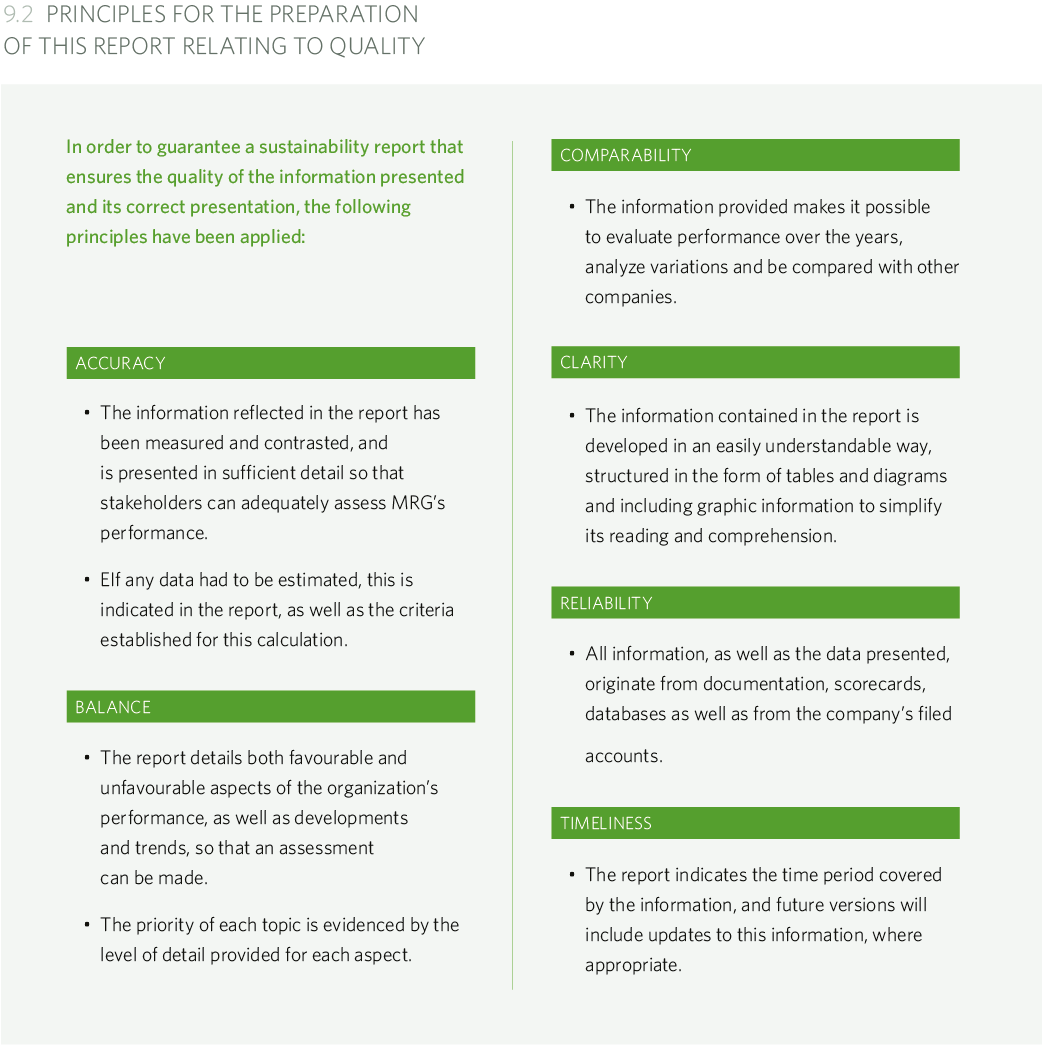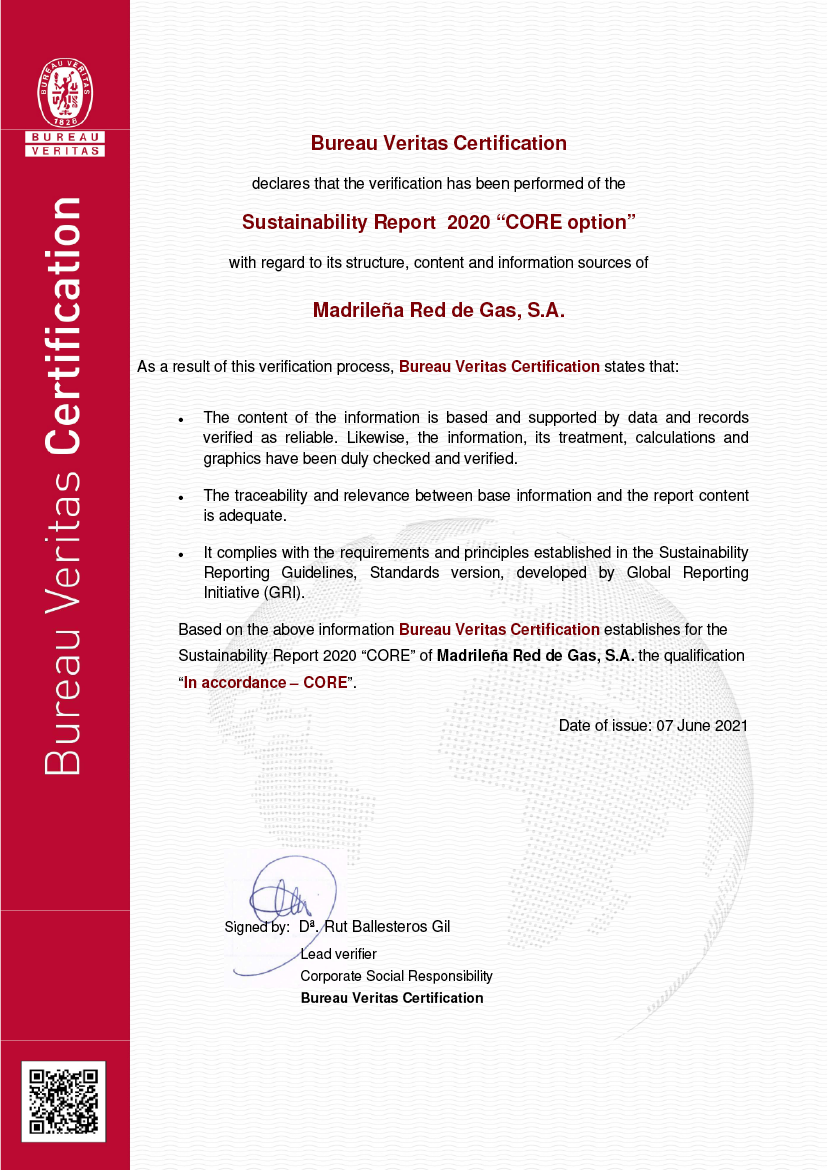9. About the report
101102-54102-55102-56
9.1 Principles for the preparation of this report relating to its contents
This is the first report published by Madrileña Red de Gas, which corresponds to the year 2020.
This report has been prepared in accordance with the Core option of the GRI Standards.
It reflects the activities of Madrileña Red de Gas in the period between 1 January and 31 December 2020, and is expected to be published annually.
The principles for the preparation of this report, referredto in the GRI 101 standard, are described below.
Context of sustainability
- The report has been developed based on sustainability aspects, which are reflected in both the sustainability strategy and the CSR policy.
- In addition, a clear identification of risks and opportunities describes how Madrileña Red de Gas deals with economic, environmental and social issues.
- The lines that define the sustainability strategy are integrated into the company’s general strategy and are perfectly aligned with the general objectives, thus demonstrating how Madrileña Red de Gas understands sustainable development.
Thoroughness
- Once the material issues have been identified, the report has been developed and structured in such a way as to reflect the importance of each of them and to show how they are managed.
- All the information provided spans the period covered by the report, as well as its evolution over the last few years.
Materiality
- This year a materiality study has been carried out, based on which the most relevant sustainability issues have been identified internally and for all stakeholders, taking into account economic, environmental and social aspects.
- As a starting point, the criteria and results of the self-assessments carried out according to the GRESB method have been taken into account.
- These issues are developed throughout the chapters of the report, being aligned in chapter 3.4. Materiality.
Stakeholder inclusion
- Madrileña Red de Gas has identified its stakeholders and has systematized a process for detecting their needs and expectations.
- This information constitutes one of the inputs for the preparation of the materiality study, which allows us to prioritize the most relevant sustainability issues.
- Throughout the development of the report, the importance of stakeholders in different areas of management is evident.
9.2 Principles for the preparation of this report relating to quality

9.3 GRI Content index
| GRI | Definition | Report |
| 101 | Foundation | 9. About the report |
| 102-1 | Name of the organization | 2.2. About us |
| 102-2 | Activities, brands, products and services | 2.2. About us 2.3. Our Business |
| 102-3 | Location of headquarters | 2.2. About us |
| 102-4 | Location of operations | 2.2. About us |
| 102-5 | Ownership and legal form | 2.2. About us 2.4. Corporate Governance |
| 102-6 | Markets served | 2.2. About us 2.3. Our Business |
| 102-7 | Size of the organization | 2.1. Key figures 2.3. Our Business 4.4. Financial Information 6.1. Human capital in figures |
| 102-8 | Information about employees and other workers | 2.1. Key figures 6.1. Human capital in figures 7. Responsible supply chain |
| 102-9 | Supply Chain | 7. Responsible supply chain |
| 102-10 | Significant Changes to the organization and its supply chain | No significant changes |
| 102-11 | Precautionary Principle or approach | 4.1. Risk management 5.1. Our environmental management |
| 102-12 | External initiatives | 2.2. About us 2.4. Corporate Governance 5.1. Our environmental management 5.2.3. Carbon footprint, measurement and commitmento 7. Responsible supply chain |
| 102-13 | Membership of associations | 2.1. About us 5.1. Our environmental management 5.2.3. Carbon footprint, measurement and commitmento 7. Responsible supply chain |
| 102-14 | Statement from senior decision-maker | 1. Chairman’s letter |
| 102-15 | Key impacts, risks and opportunities | 4.1. Risk Management |
| 102-16 | Values, principles, standards and norms of behaviour | 3.2. Mission, vision and values 4.3. Ethical behaviour |
| 102-17 | Mechanisms for advice and concerns about ethics | 3.2. Mission, vision and values 4.3. Ethical behaviour |
| 102-18 | Governance structure | 2.4. Corporate Governance |
| 102-19 | Delegating authority | 2.4. Corporate Governance |
| 102-20 | Executive-level responsibility for economic, environmental and social topics | 2.4. Corporate Governance |
| 102-21 | Consulting stakeholders on economic, environmental and social topics | 3.4. Stakeholder engagement |
| 102-22 | Composition of the highest governance body and its committees | 2.4. Corporate Governance |
| 102-23 | Chair of the highest governance body | 2.4. Corporate Governance |
| 102-24 | Nomination and selecting the highest governance body | 2.4. Corporate Governance |
| 102-25 | Conflicts of interest | 2.4. Corporate Governance |
| 102-26 | Role of the highest governance body in setting purpose, values and strategy |
2.4. Corporate Governance |
| 102-27 | Collective knowledge of the highest governance body | 2.4. Corporate Governance |
| 102-28 | Evaluating the highest governance body’s performance | 2.4. Corporate Governance |
| 102-29 | Identifying and managing economic, environmental and social impacts | 2.4. Corporate Governance 4.1. Risk Management |
| 102-30 | Effectiveness of risk management processes | 4.1. Risk Management |
| 102-31 | Review of economic, environmental and social topics | 2.4. Corporate Governance 4.1. Risk Management |
| 102-32 | Highest governance body’s role in sustainability reporting |
1. Chairman’s letter |
| 102-33 | Communicating critical concerns | 2.4. Corporate Governance 4.1. Risk Management |
| 102-34 | Nature and total number of critical concerns | 4.1. Risk Management |
| 102-35 | Remuneration policies | 6.3. Equality and diversity |
| 102-36 | Process for determining remuneration | 6.3. Equality and diversity |
| 102-37 | Stakeholders’ involvement in remuneration | 2.4. Corporate Governance |
| 102-38 | Annual total compensation ratio | 6.3. Equality and diversity |
| 102-39 | Percentage increase in annual total compensation ratio | 6.3. Equality and diversity |
| 102-40 | List of stakeholder groups | 3.4. Stakeholder engagement |
| 102-41 | Collective bargaining agreements | 6.2. Human Resources Practices |
| 102-42 | Identifying and selecting stakeholders | 3.4. Stakeholder engagement |
| 102-43 | Approach to stakeholder engagement | 3.4. Stakeholder engagement |
| 102-44 | Key topics and concerns raised | 3.4. Stakeholder engagement |
| 102-45 | Entities included in the consolidated financial statements | 4.4. Financial Information |
| 102-46 | Defining report content and topic Boundaries | 3.5. Materiality Analysis |
| 102-47 | List of material topics | 3.5. Materiality Analysis |
| 102-48 | Restatements of information | Not applicable (this is the first report published) |
| 102-49 | Changes in reporting | Not applicable (this is the first report published) |
| 102-50 | Reporting period | Corresponds to the year 2020 |
| 102-51 | Date of most recent report | Not applicable (this is the first report published) |
| 102-52 | Reporting cycle | Annual reports are foreseen |
| 102-53 | Contact point for questions regarding the report | prevencion@madrilena.es |
| 102-54 | Claims of reporting in accordance with the GRI standards | 9. About the Report |
| 102-55 | GRI content index | 9. About the Report |
| 102-56 | External assurance | 9. About the Report |
| 103-1 | Explanation of the material topic and its Boundary | 3.5. Materiality Analysis |
| 103-2 | The management approach and its components | 3.5. Materiality Analysis |
| 103-3 | Evaluation of the management approach | 3.5. Materiality Analysis |
| 201-1 | Direct economic value generated and distributed | 4.4. Financial information 8. Society |
| 201-2 | Financial implications and other risks and opportunities due to climate change |
4.2.1. Climate change strategy |
| 201-3 | Defined benefit plan obligations and other retirement plans | 6.2. Human Resources Practices |
| 202-1 | Ratios of standard entry level wage by gender compared to local minimum wage | No employee is paid based on minimum wage rules. |
| 202-2 | Proportion of senior management hired from the local community | 0.7% of senior executives with a permanent address in the Community of Madrid. Senior executives means the Chief Executive Officer. |
| 203-1 | Infrastructure investments and services supported | 4.4. Financial information 8. Society |
| 203-2 | Significant indirect economic impacts | 2.2. About us 8. Society |
| 204-1 | Proportion of spending on local suppliers | 7. Responsible supply chain |
| 205-1 | Operations assessed for risks related to corruption | 4.3. Ethical behaviour |
| 205-2 | Communication and training about anti-corruption policies and procedures | 4.3. Ethical behaviour |
| 301-1 | Materials used by weight or volume | 5.2. Our commitment in figures 5.2.1. Resource consumption |
| 301-2 | Recycled input materials used | 5.2.5. Waste |
| 301-3 | Reclaimed products and their packaging materials | 5.2.5. Waste |
| 302-1 | Energy consumption within the organization | 5.2. Our commitment in figures |
| 302-2 | Energy consumption within the organization | 5.2. Our commitment in figures |
| 302-4 | Reduction of energy consumption | 5.1. Our environmental management 5.2.1. Resource consumption |
| 302-5 | Reductions in energy requirements of products and services | 5.2.1. Resource consumption |
| 303-5 | Water consumption | 5.2. Our commitment in figures |
| 304-1 | Operational sites owned, leased, managed in, or adjacent to, protected areas and areas of high biodiversity value outside protected areas |
5.3. Biodiversity |
| 304-2 | Significant impacts of activities, products, and services on biodiversity | 5.3. Biodiversity |
| 304-3 | Habitats protected or restored | 5.3. Biodiversity |
| 304-4 | IUCN Red List species and national conservation list species with habitats in areas affected by operations |
5.3. Biodiversidad |
| 305-1 | Direct GHG emissions | 5.2.2. Atmospheric emissions |
| 305-2 | Energy indirect GHG emissions | 5.2. Our commitment in figures 5.2.2. Atmospheric emissions |
| 305-3 | Other indirect GHG emissions | 5.2.2. Atmospheric emissions 5.2.3. Carbon footprint, measurement and commitment |
| 305-5 | Reduction of GHG emissions | 5.2.2. Atmospheric emissions 5.2.3. Carbon footprint, measurement and commitment 5.2.4. Projects and investments to promote energy efficiency and reduce emissions |
| 305-6 | Emissions of ozone-depleting substances (ODS) | 5.2.2. Atmospheric emissions 5.2.3. Carbon footprint, measurement and commitment |
| 305-7 | Nitrogen oxides (NOx), sulphur oxides (SOx) and other significant air emissions | 5.2.3. Carbon footprint, measurement and commitment |
| 306-1 | Waste generation and significant waste-related impacts | 5.2.5. Waste |
| 306-2 | Management of significant waste-related impacts | 5.2.5. Waste |
| 306-3 | Waste generated | 5.2.5. Waste |
| 306-4 | Waste diverted from disposal | 5.2.5. Waste |
| 306-5 | Waste directed for disposal | 5.2.5. Waste |
| 307-1 | Non-compliance with environmental laws and regulations | 5.1. Our environmental management No fines or sanctions have been recorded. |
| 308-1 | New suppliers that were screened using environmental criteria. | 5.1. Our environmental management |
| 308-2 | Negative environmental impacts in the supply chain and actions taken | 5.1. Our environmental management |
| 401-1 | New employee hires and employee turnover | 6.3. Equality and diversity |
| 401-2 | Benefits provided to full-time employees that are not provided to temporary or part-time employees |
6.2. Human Resources Practices No variance applicable |
| 401-3 | Parental leave | 6.2. Human Resources Practices |
| 402-1 | Minimum notice periods regarding operational changes | 6.2. Human Resources Practices |
| 403-1 | Occupational health and safety management system | 6.6. Health and Safety |
| 403-2 | Hazard identification, risk assessment and incident investigation | 6.6. Health and Safety |
| 403-3 | Occupational health services | 6.6. Health and Safety |
| 403-4 | Worker participation, consultation and communication on occupational health and safety |
6.6. Health and Safety |
| 403-5 | Workers training on occupational health and safety | 6.6. Health and Safety |
| 403-6 | Promotion of worker health | 6.6. SHealth and Safety |
| 403-7 | Prevention and mitigation of occupational health and safety impacts directly linked by business relationships |
6.6. Health and Safety |
| 403-8 | Workers covered by an occupational health and safety management system | 6.6. Health and Safety |
| 403-9 | Work-related injuries | 6.6. Health and Safety |
| 403-10 | Work-related ill health | 6.6. Health and Safety |
| 404-1 | Average hours of training per year per employee | 6.4. Talent Management |
| 404-2 | Programs for upgrading employee skills and transition assistance programs | 6.4. Talent Management |
| 404-3 | Percentage of employees receiving regular performance and career development reviews |
6.4. Talent Management |
| 405-1 | Diversity of governance bodies and employees | 6.3. Equality and diversity |
| 405-2 | Ratio of basic salary and remuneration of women to men | 6.3. Equality and diversity |
| 406-1 | Incidents of discrimination and corrective actions taken | No cases have been confirmed. |
| 407-1 | Operations and suppliers in which the right to freedom of association and collective bargaining may be at risk |
7. Responsible supply chain |
| 408-1 | Operations and suppliers with significant risk for incidents of child labour | 7. Responsible supply chain |
| 409-1 | Operations and suppliers with significant risk for incidents of forced or compulsory labour |
7. Responsible supply chain |
| 410-1 | Security personnel trained in human rights policies or procedures | 4.3. Ethical behaviour |
| 411-1 | Incidents of violations involving rights of indigenous peoples | Not applicable, as the company is located in the Community of Madrid. |
| 412-2 | Employee training on human rights policies or procedures | 6.3. Equality and diversity |
| 413-1 | Operations with local community engagement, impact assessments and development programs |
4.1. Risk Management |
| 413-2 | Operations with significant actual and potential negative impacts on local communities |
5.1. Our environmental management |
| 415-1 | Political contributions | It is not applicable, as it is prohibited by the code of ethics. |
| 419-1 | Non-compliance with laws and regulations in the social and economic area | No non-compliance has been recorded |
Annex


